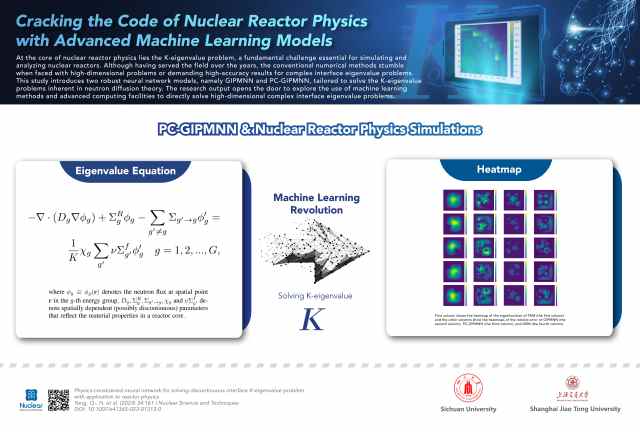博文
[转载]利用先进的机器学习模型破解核反应堆物理学之谜
||
上海交通大学-四川大学AISEA团队(AI for Science with Engineering Application)成果
Article title: Physics-constrained neural network for solving discontinuous interface K-eigenvalue problem with application to reactor physics
文章标题:应用于反应堆物理学的物理约束神经网络,用于解决不连续界面K-本征值问题
DOI: 10.1007/s41365-023-01313-0
One sentence summary:
一句话概要:
Machine learning models, specifically the PC-GIPMNN, are revolutionizing nuclear reactor simulations, offering enhanced accuracy and efficiency, and paving the way for a sustainable energy future.
特别是PC-GIPMNN这样的机器学习模型,正在彻底改变核反应堆模拟,提供更高的准确性和效率,并为可持续能源未来铺平道路。

Keywords:
关键词:
Neural network, Reactor physics, Neutron diffusion equation, Eigenvalue problem, Inverse power method
神经网络,反应堆物理学,中子扩散方程,本征值问题,逆幂法
The Novelty (What)
创新性(主要内容)
This study introduces two robust neural network models, namely Generalized Inverse Power Method Neural Network (GIPMNN) and Physics-Constrained GIPMNN (PC-GIPMNN), tailored to solve the K-eigenvalue problems inherent in neutron diffusion theory, which is a cornerstone in nuclear reactor physics. Falling under the domain of "Analysis and Application of Machine Learning Algorithms, this research led to the integration of nuclear engineering and advanced applied mathematics. Through a computational (in-situ) model, the study embarks on a comparative journey revealing that the PC-GIPMNN significantly outshines both GIPMNN and the existing deep learning methods for eigenvalue problem especially in managing two-dimensional scenarios and interface problems. The key findings underscore PC-GIPMNN's superior accuracy and stability in tackling these problems, making it a promising asset for complex nuclear engineering computations. This advancement opens up a promising avenue for further enhancements in machine learning applications within nuclear reactor physics, aiming to bring about a new era of efficiency and precision in nuclear energy simulations.
这项研究提出了两种强大的神经网络模型,即广义逆幂法神经网络(GIPMNN)和物理约束GIPMNN(PC-GIPMNN)。中子扩散理论是核反应堆物理学的基石,而这两种模型专门用于解决中子扩散理论中固有的K-本征值问题。这项研究属于“机器学习算法的分析与应用”领域,它实现了核工程和先进应用数学的整合。通过即时计算模型,该研究进行了对比分析,结果显示PC-GIPMNN在处理二维情况和界面问题时,明显优于GIPMNN和现有的深度学习方法。关键发现强调了PC-GIPMNN在解决这些问题时的高精度和稳定性,使其成为复杂核工程计算中的有力工具。这一进展为核反应堆物理学中机器学习应用的进一步提升开辟了新的途径,旨在引领核能模拟的效率和精确度进入新时代。
The Background (Why)
研究背景(主要原因)
At the core of nuclear reactor physics lies the K-eigenvalue problem, a fundamental challenge essential for simulating and analyzing nuclear reactors. In simpler terms, it's a mathematical hurdle that, when resolved, provides critical insights into the behavior and safety of nuclear reactors.
Although having served the field over the years, the conventional numerical methods stumble when faced with high-dimensional problems or demanding high-accuracy results for complex interface eigenvalue problems. The thrust of this study is propelled by these existing limitations, offering a novel solution through the lens of machine learning. The proposed neural network models, GIPMNN and PC-GIPMNN, emerge as a significant stride towards bridging this knowledge gap. By leveraging the prowess of machine learning, these models herald a notable potential in not only addressing the immediate challenges but also setting a precedent for future explorations in nuclear reactor simulations and analysis.
核反应堆物理学的核心是K-本征值问题,这是模拟和分析核反应堆的一个基本挑战。简单来说,这是一个数学难题,一旦解决,便能对核反应堆的操作和安全性提供关键洞察。 尽管传统的数值方法多年来一直服务于这一领域,但面对高维问题或复杂界面本征值问题要求的高精度结果时,这些方法常常遇到困难。这项研究的动力源自于这些现存的局限性,通过机器学习的视角提供了一种创新解决方案。所提出的神经网络模型,GIPMNN和PC-GIPMNN,标志着弥合这一知识差距的重要一步。利用机器学习的力量,这些模型不仅在解决当前挑战方面显示出显著潜力,而且为未来核反应堆模拟和分析的探索树立了一个先例。
The SDG impact (Big Why)
SDG影响力(研究意义)
According to the International Energy Agency, nuclear power is pivotal in achieving low-carbon electricity generation. The urgency to improve the efficiency and accuracy in nuclear reactor simulations is a stepping stone towards a sustainable energy future. This research resonates profoundly with Sustainable Development Goal 7 (Affordable and Clean Energy) by pushing the boundaries in nuclear reactor physics through machine learning, aiming to enhance the efficiency and safety of nuclear energy. Furthermore, the potential of this research in fostering innovation aligns with Goal 9 (Industry, Innovation, and Infrastructure), paving the way for digital transformations in nuclear engineering.
根据国际能源署,核电在实现低碳电力生成方面发挥着关键作用。提高核反应堆模拟的效率和准确性迫在眉睫。因为这是实现可持续能源未来的重要一步。这项研究与可持续发展目标7(可负担的清洁能源)产生了深刻的共鸣,通过将机器学习应用于核反应堆物理学,旨在提高核能的效率和安全性。此外,这项研究在促进创新方面的潜力与目标9(产业,创新和基础设施)相契合,为核工程的数字化转型铺平了道路。
https://m.sciencenet.cn/blog-3474219-1420095.html
上一篇:上海质子治疗:癌症治疗的巨大跨越
下一篇:[转载]机器学习对预测超重元素衰变的影响